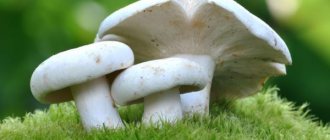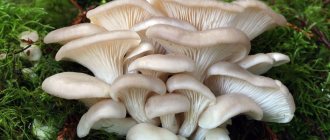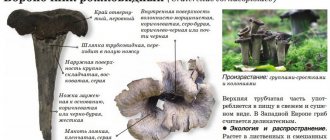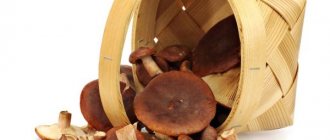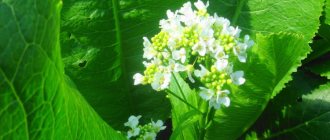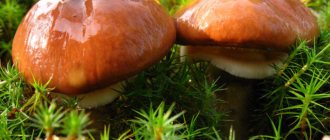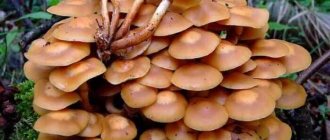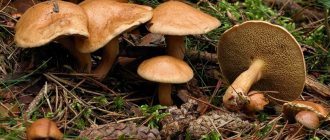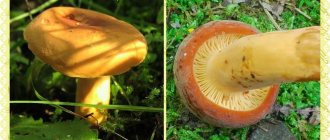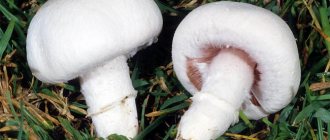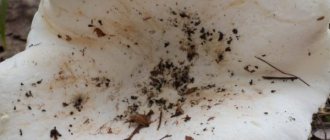» Mushrooms » False milk mushrooms: can they be eaten?
0
3639
Article rating
The group of conditionally edible mushrooms is very large. At the same time, experienced mushroom pickers hunt for them with pleasure, because such specimens are quite suitable for food. The main thing is to soak or boil them additionally before cooking. They are great for pickling and pickling. In particular, housewives value real and false milk mushrooms, which include more than 10 different types.
- Skripun
- Description
- How is it different from milk mushrooms?
- Gorchak
- Description
- How is it different from milk mushrooms?
- Pig
- Description
- How is it different from milk mushrooms?
- Spruce row
- Description
- How is it different from milk mushrooms?
- Toadstool
- Description
- How is it different from milk mushrooms?
- Blue-tailed white-necked
- Description
- How is it different from milk mushrooms?
- Common milkweed
- Description
- How is it different from milk mushrooms?
- Let's sum it up
False milk mushrooms: can they be eaten?
Milk mushrooms: types, benefits
The breast is considered a real Russian mushroom. In Western, Eastern and Southern countries they don’t even know about them.
In our region, these mushrooms were able to firmly enter the consciousness of every person. They are considered the most wonderful forest gift, and therefore have won the hearts of our compatriots.
In many regions of Russia, for example, in Siberia, these mushrooms were one of the types of industrial mushrooms for a long period of time. Ideal nutritional properties combined with widespread fruiting are why they are in demand among people.
The main purpose of the mushroom is pickling. Other dishes must be prepared from salted preparations. But mushrooms are not suitable for frying, stewing and other similar cooking methods.
Milk milk contains so much protein that it can easily replace meat. The particular benefit of the mushroom is that it is used to create drugs that fight tuberculosis. After all, the components of the mushroom are able to neutralize the dangerous Koch bacillus. Next, we will consider in detail the types of mushrooms.
Causes of milk mushroom poisoning
Is it possible to get poisoned by milk mushrooms? Many people know first-hand. Such cases are common during the mushroom season. Causes of poisoning:
- Edible mushrooms have not been properly processed. If the milky juice is not removed by soaking, they, like poisonous ones, cause poisoning of varying degrees of severity.
- Improper preparation of canned food creates favorable conditions for the growth of bacteria that produce botulism toxins.
- Eating low-quality milk mushrooms - wormy or spoiled dried ones.
- Edible mushrooms can be poisoned if they are overripe or stored for more than 24 hours before processing.
- The presence of a poisonous mushroom in a basket with milk mushrooms can poison the entire collected batch.
Intoxication also occurs due to the individual characteristics of the body. Some people suffer from intolerance to mushroom dishes.
White and black milk mushrooms: benefits and harms
Many people claim that mushrooms are either edible or poisonous. However, there are also conditionally edible ones. This category includes black milk mushrooms.
Professional mushroom pickers, of course, know about this. But beginners don’t know this. This type of mushroom is called conditionally edible because it contains poison.
Milk mushrooms: harm and benefit
If you just fry black milk mushrooms in a frying pan, then this poison will not disappear anywhere. As a result, you can get severely poisoned or even die.
Such mushrooms must be washed thoroughly, and then cooked for 3 hours. Only in this way will all the poison disappear.
White milk mushroom brings both harm and benefit to the human body. It all depends on how well the mushroom is prepared.
First aid and hospital treatment
If, after eating milk mushrooms, characteristic symptoms appear, the first thing you should do is call an ambulance and immediately provide first aid.
First aid
First aid is provided in several stages. The cost of a patient’s life largely depends on the speed of the measures taken.
Providing assistance to the victim:
- Gastric lavage. If there is no vomiting, you should drink at least 1.5 liters of liquid. It is recommended to use a weak saline solution or a light solution of potassium permanganate as a cleaning agent. Vomiting is induced by pressing on the root of the tongue with two fingers.
- If there is no diarrhea, it is recommended to take a laxative or give an enema. The procedure is carried out to cleanse the intestines of toxins absorbed into its walls.
- Ensure air flow into the room. Poisoning is often accompanied by nausea, which causes the patient to have an irregular breathing rhythm; in order to alleviate the condition, access to fresh air must be given.
- Reception of sorbents. Adsorbent drugs absorb toxic components and remove them from the body.
- Drink plenty of fluids. Any poisoning accompanied by vomiting and diarrhea contributes to severe dehydration. To prevent the condition, drinking plenty of warm fluids is recommended.
Attention. It is often mistakenly assumed that a glass of strong alcoholic drink can stop the symptoms of poisoning and lift the victim out of a serious condition. But we must warn you right away: alcohol only makes the situation worse! Alcohol consumption is strictly prohibited.
Please note that doctors do not recommend taking any medications that reduce symptoms before the ambulance arrives. Each of them can complicate the patient’s condition.
Hospital treatment
As medical practice shows, timely provision of first aid facilitates further treatment in a hospital. The main goal of doctors is to stop the absorption of toxins into the blood and remove them from the body.
In case of severe dehydration, the patient is prescribed droppers based on solutions that restore the water-salt balance in the body. For persistent vomiting, antiemetic medications are recommended. And, of course, taking adsorbents that absorb remaining toxic substances.
Any intoxication requires diet. The patient should absolutely refuse heavy foods. On the first day, complete fasting is recommended, and starting from the second day, low-fat chicken broth with crackers will be useful.
If critical symptoms appear, call an ambulance immediately!
Not everyone knows that even real milk mushrooms can be dangerous to humans. You can be poisoned by milk mushrooms if they are collected in places with high concentrations of toxic substances (near highways, pharmaceutical factories, industrial plants, landfills, etc.). But by following simple rules for collecting mushrooms and preparing them, poisoning can be avoided and you can enjoy mushroom delicacies without much danger. The video in this article will tell our readers more about the risks of pathology.
Where, in what forest do milk mushrooms grow?
There are situations when in one forest there will be a lot of mushrooms, in another there will be very few or only poisonous ones. Choosing the right forest is a huge success in finding them. If you decide to go for milk mushrooms, pay attention to our recommendations:
- The forest should be neither young nor old. After all, mushrooms have not yet appeared in a very young forest, and the old forest is very overgrown.
- Low grass should grow around each tree. As a rule, mushrooms are practically not found in tall grass.
Milk mushrooms in the forest
- Choose a forest that is very humid or try to go in the morning when dew has fallen.
- In a good area you can smell mushrooms. In the area where you want to find milk mushrooms, there is usually a mushroom smell and a moist aroma.
When to pick milk mushrooms?
If you decide to go in search of a milk mushroom, then you should consider the following: as a rule, this mushroom grows in lowlands, because they do not like dry soil. If sandy or dry soil predominates in the forest where you are going, then you don’t have to look for milk mushrooms there.
Collection of milk mushrooms
Now let's figure out exactly when it is necessary to collect these mushrooms. It all depends on their variety:
- Look for oak or aspen mushrooms at the end of July and until the end of September
- It is better to look for blue milk mushrooms closer to August and until the end of this month
- You can start collecting yellow and pepper milk mushrooms from mid-summer until the end of August
- If you want to find the black species, then head into the forest in July. They will grow there until September
Of course, the terms that we have offered you are considered only conditional. Remember that when you collect these mushrooms, make sure that the forest is sufficiently moist. Because milk mushrooms do not grow in dry soil.
In addition, take a closer look at the local vegetation. If you notice horsetail, then you will not find mushrooms in this area. This plant is considered the first sign that the soil in this forest is acidic. But milk mushrooms don’t like such soil.
Spruce row
Description
Ryadovka grows in coniferous forests
There is still debate about its toxicity, but that it is inedible is a recognized fact.
So named for its habitat, as it prefers damp spruce and pine forests.
How is it different from milk mushrooms?
Often confused with the greenfinch, however, it is distinguished from it by its tall, hollow stem and lighter colored cap.
But it can only be confused with milk mushrooms due to inattention. The latter never grow in coniferous forests; you need to look for them near birch trees, since it is with this tree that they form a symbiosis.
Are there false milk mushrooms, poisonous, what do they look like, how to distinguish them from real ones?
Among the large assortment of edible types of mushrooms, milk mushrooms are given one of the first places. There is no mushroom picker who can bypass this mushroom, since it is distinguished by its rather bright and nutritious taste.
It’s a shame, but you can often find false squeaky mushrooms, which have a number of distinctive features. In addition, the papillary milk mushroom may end up in the basket. It can cause quite serious poisoning.
False breast
If you want to understand what exactly this mushroom looks like, you need to see a real one in person. You also need to get acquainted with the main distinguishing features and compare these features with the appearance of false mushrooms.
- The initial appearance of the cap of an edible mushroom is this: the cap is convex and has curled edges. Over time, the cap takes on a different shape. Its edges rise, creating a funnel shape in the central part.
- The cap of the edible mushroom is moist and quite dense. May have a white or cream color. As a rule, it is covered with twigs, dirt, and mucus.
- The plates of the edible mushroom are white, with yellow edges. The edges themselves are wide or quite loose. If you take a false mushroom, then it has dense, hard and thick plates that look unnatural. Often, it is thanks to the plates that one can distinguish a real milk mushroom from a poisonous one.
- Real milk mushrooms have a large amount of milky juice.
- The edible mushroom has only white flesh.
Milk mushroom is a mushroom that has a large number of false twins. But many of these mushrooms are considered conditionally edible, since according to certain characteristics they are similar to real ones.
Common milkweed
Description
A conditionally edible mushroom of the Russula family. At first glance, it resembles a milk mushroom, only with a more even cap. They have similar shades, both dark in the middle.
The hat always shines, regardless of weather conditions, and concentric circles are clearly visible on it.
The leg is hollow, gray or brown in color. The pulp is white; when damaged, it secretes a milky juice, which, as it dries, acquires an olive-brown hue.
Milk mushrooms Edible or not edible Poisonous or not poisonous
Differences between mushrooms. White milk mushroom and squeaky mushroom Edible mushrooms
Squeaky milk mushroom / How to distinguish /
How is it different from milk mushrooms?
The peculiarity of lacticifers is that they can be found in coniferous forests, but they appear more readily near birch trees.
What poisonous mushroom can be confused with milk mushroom?
The milkweed, which has a gray-pink color, is very similar to the white milk mushroom. It should not be eaten as it is considered deadly to the human body.
This mushroom has a cap up to 12 cm wide, dense, fleshy, convex or flattened in the form of a funnel. From the very beginning, the cap of the mushroom has bent edges, which eventually droop, dry out, and become covered with small scales. As the mushroom ages, its cap becomes bare, becomes red, pink or pink-brown, and after drying, blurry spots appear on the cap.
Milky
The leg of the milkweed is dense, up to 8 cm long and up to 4 cm wide. The shape is in the form of a cylinder. The flesh of the mushroom is yellow with a red tint. The bottom of the leg is colored reddish-brown. The milkweed grows from mid-summer to mid-autumn.
What does a truly royal mushroom look like?
A real milk mushroom has a milky white or yellowish cap. In young fruiting bodies it is flat, and as it grows it takes on the shape of a funnel. Its edges are tightly rolled inward and decorated with a small fringe. The thick leg is hollow inside. The pulp is white, with a fruity aroma. The milky sap is very caustic and turns yellowish when exposed to air.
This milk mushroom prefers proximity to a birch tree. Grows in deciduous and mixed forests. Milk mushrooms are collected from July to September.
In Europe it is considered false, inedible due to its bitterness, while in Russia it is exceptionally good for pickling. In the old days it was called the “king of mushrooms.” From time immemorial, during Lent it was considered a real table decoration.
Milk mushrooms are very difficult to find. They hide under leaves, but always grow in large groups. Therefore, mushroom pickers who are lucky enough to find them never leave with an empty basket. On the contrary, they begin to look for containers where else they can put the milk mushrooms. And they try to remember the places where this amazing and not false mushroom grows.
How to distinguish a black milk mushroom from a pig?
- The pig mushroom is considered to be a lamellar mushroom. It differs from the milk mushroom in that the size of its cap is 20 cm
- The young mushroom has a convex, and over time flat, funnel-shaped, velvety, yellow-brown cap
- The flesh of the mushroom has a light brown tint, which darkens after cutting.
- The plates of the mushroom in the lower part are connected by cross veins
- These veins can be separated from the cap without any problems
pigs
- Leg length is narrow, plain, approximately 9 cm
- It is located in the center or slightly to the side
- As a rule, the mushroom is found in a variety of forests, in the form of large groups
- Breeding period is from mid-summer to mid-October
A fat pig has a larger size. Its color is dark brown, and the stem of the mushroom is velvety. In the first and second types, a large number of harmful compounds accumulate, including heavy metals.
Where to look and how to collect
Before you go to replenish your cellar, you need to figure out what your future goal looks like. They grow in mixed forests, or spruce forests, birch groves, and wild parks. Chernushki prefer to live in groups, so some aces generally collect them, looking for them on a crawl.
The reason for this is the desire to find young specimens, which are often hidden under a small layer of earth and fallen leaves. To find the best options, you have to crawl, picking out suspicious bumps near the trees with a spatula. Experts say that picking only babies really justifies the effort invested in their search.
If a forest dweller really likes the soil, then in one place they will literally overlap each other. In this case, each cap will be from five to fifteen centimeters in diameter. If you're lucky, you can find a giant with a girth of 20 centimeters, but such representatives are considered old and many prefer not to cut them. They are often wormy inside.
The description of young animals is slightly different from adults. The juveniles have a smooth, slightly convex cap, while the “parents” are funnel-shaped. The skin usually has a brown tone with a reddish tint. Even less common are faint rings or blackish spots with a greenish tint. This is acceptable. After boiling them or sending them to pickle, the color quickly changes to a rich cherry tone.
If you go on a quiet hunt right after the rain, you can find accumulated moisture right on the cap. But the plates of young milk mushrooms, regardless of the weather, have a creamy tint. As they grow older, the color becomes more saturated, and in some places even with greenish tints.
One of the most important methods for determining that a real edible forest dweller has been found is the cut test. Immediately after excision, the pulp pleases with its pleasant whiteness, but rather quickly turns gray and/or brown. An additional fact in favor of safety is the release of white caustic juice.
The leg sometimes reaches a height of up to 6 cm, and the girth width is 3 cm. Only if the young ones have stocky legs, then the older ones are hollow, which makes salting them useless.
The crispy gifts of nature have a characteristic aroma that cannot be confused with anything else, as well as a specific taste, which manifests itself especially clearly if various salting methods are used.
How to distinguish a white milk mushroom from a toadstool?
The white milk mushroom does not have a thickening in the form of a tuber, which is located at the bottom of the toadstool's stem. The toadstool itself is considered a rather dangerous mushroom. Basically, its appearance resembles that of russula.
Toadstool
The grebe has a green cap, in some cases almost white. There is a ring on the stem of the mushroom near the cap. If you do not want to confuse this mushroom with white milk mushroom, remember the following rule: mushrooms that are intended for pickling have a hole on the stem. This indicates that this or that mushroom is considered edible.
How to process milk mushrooms after harvesting?
You need to know that each mushroom tends to deteriorate quickly, therefore, they need to be washed and cleaned as quickly as possible.
- To begin, wipe the mushroom with a dry piece of cloth.
- Then remove dark places from it and clean the leg from dirt.
- If the mushroom is very dirty or wormy, then it must be placed in cool, salty water.
- After soaking the mushroom, you can cook it.
Pickling mushrooms
There are several ways to get white milk mushrooms.
Classic recipe
Soak the mushrooms in water, adding a little citric acid and salt. Let it sit for two days, but change the water every morning and every evening. Now place the mushrooms in a glass jar. There should be a little salt at the bottom of the container (a thin layer). Milk mushrooms are placed with their caps down. Sprinkle salt on top. Please note that 1 kg of product contains about 45 grams of salt. When the jar is full, cover it with a cloth. Place a circle on top and place a weight on it.
After a couple of days, juice from the mushrooms will appear and they will thicken. This will allow you to add more milk mushrooms to the jar. Do this until the mushrooms stop settling. Do not remove the load. Upon completion of the mushrooms, they should be in brine. If it is not enough, add some boiled water with a small amount of salt. The product is salted for 1-1.5 months in a cold place.
Pickling mushrooms.
Quick salting
To do this, the mushrooms are soaked for a day and then peeled. Fill with cold water and cook for 20 minutes after the water boils. Now add black pepper (peas), a little salt, bay leaves, maybe cloves. This will result in a flavorful brine. Let cool, add vegetable oil and chopped onion. Best served with potatoes.
